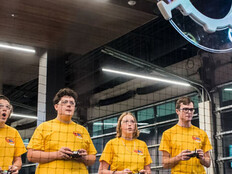Q&A: Talking Tech and Mobility with CoSN's Marie Bjerede
Marie Bjerede spent 25 years of her professional life as a veteran executive leader who developed high-tech and wireless communications.
From there, she became a nationally recognized authority on mobile learning and the principal for the Consortium for School Networking’s (COSN’s) Leadership for Mobile Learning (LML) and Smart Education Networks by Design (SEND) initiatives.
We caught up with Bjerede to get her take on teaching with technology and where she sees the future of educational technology going.
EDTECH: What are some major themes you’re seeing emerge in the educational technology space?
BJEREDE: The most important shift I see is one toward students owning their learning. This shows up as personalized learning, blended learning or mastery-based learning. What all of these have in common is how they have the potential to activate intrinsic motivation. Technology is key to this shift in that it allows this personalization to be scaled.
EDTECH: For schools that want to begin bring-your-own-device or one-to-one programs, what is some advice you can offer?
BJEREDE: First, consider the “why.” Every decision and plan and policy that is made down the road will be guided by the fundamental “why” of embarking on the digital leap. If there is a lack of reasoning behind the decision, or if the reasons are shallow, such as “kids are digital natives, and they need digital tools,” or “we want to increase engagement,” then the program will lose its way. If there is a strong “why,” such as “help students be ready for careers in a digital world,” then the program has a true north for decision-making.
EDTECH: How should schools build their networks to support mobility, not just now but into the future?
BJEREDE: CoSN has found that it is not uncommon for districts to require increased bandwidth of 60 percent, year over year, once they embark on the digital leap. This means that network capacity needs to double every 18 months and may increase by almost an order of magnitude during the five years of an average technology plan. Networks need to be scalable. The constant demand for usage by students and administrators means the network needs to be reliable. The considerations of finance mean that the network needs to be sustainable.
To meet all these requirements and more, many districts choose to take control of their Internet and transport by taking ownership or leasing the fiber that goes from their schools to an Internet point of presence where there are multiple Internet vendors available, leading to competition; and virtual data centers available, leading to flexibility and cost savings.
These districts then size all their Internet appliances carefully to ensure they retire the equipment just as it becomes inadequate to support the demands of the district. This helps them take best advantage of the decreases in the costs of such equipment over time. Finally, districts need to look for alternative on-ramps to the Internet other than the comparatively expensive commodity Internet offerings.
EDTECH: You’ve been critical of the false dichotomy between improving K–12 test scores and preparing for life and work in the 21st century. What are some ways we should use technology to prepare students for college and a constantly evolving workplace?
BJEREDE: The key to preparing for life and work in the 21st century is to activate students’ intrinsic motivation and let them take ownership of their learning.
Technically, this doesn’t require technology. Socrates did pretty well without it. However, with technology it is possible to scale the student-centered teaching practices that foster intrinsic motivation. Inquiry, for example, encourages students to use devices to find answers to tricky and even contested questions on the Internet, to grapple with and formulate their own answers. Making encourages students to learn by doing. They are creating technology and not just learning with it.
Mobile learning makes it possible to make learning situated at scale. Game-based learning has the potential to provide immersive environments with challenges in each student’s proximal zone of development. Project-based learning prepares students for the collaborative and iterative nature of the modern workplace. The Internet can provide an authentic audience for student work.
When students grapple deeply with topics and create a substantial frame of understanding, the fairly superficial activity of choosing the right answer from a multiple choice test becomes relatively simple.
EDTECH: Are mobile phones equipped to do standardized testing? Is that a future you see happening?
BJEREDE: That won’t happen without significant advances in the user interface. One can imagine a very sophisticated UI that includes augmented reality that allows students to interact in much richer ways than the multiple-choice test, which is not suited to the small screen and keyboard of the smartphone.
EDTECH: Can you tell us a little bit about the Smart Education Networks by Design program and its purpose?
BJEREDE: The SEND program is intended to provide resources for CoSN members regarding the design of modern education networks. The demands on these networks are increasing exponentially, and not all networks are created equal. Depending on the vision and instructional goals of the district, decisions about this expensive and complex infrastructure will go in different directions.
SEND points toward the newest trends in network design and the evolution of network requirements based on the experiences of both district technology leaders and leading industry partners who are developing these new technologies.









